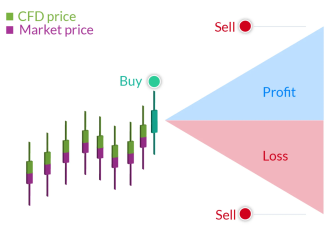Extended Comparative Analysis: CFDs versus Traditional Stock Trading
Within the financial markets, there exist two prominent trading instruments: Contracts for Differences and conventional stock trading. Both have distinct advantages and represent different financial models that attract different investors with varying risk appetites and investment timeframes. To delve deeper into the dynamic world of CFDs, Dukascopy provides an extensive guide explaining these instruments. Their guide offers insights into leveraging market movements, understanding risks, and strategic uses of CFDs. Enhance your trading knowledge by visiting Dukascopy's expert guide on cfds.
Expanded Ownership and Market Access
CFDs:
- CFD traders engage with the price movements of assets without actual ownership, which allows for trading across a broad spectrum of markets not limited to stocks. This includes commodities, forex, bonds, and sector indices.
- This non-ownership approach facilitates international market access without the complexities of cross-border regulations and substantial capital requirements.
Traditional Stocks:
- Owning stocks means literally having a physical share of a company, and this often includes the added benefits of being a shareholder in the company, such as dividends and voting rights at the shareholder meetings.
- What is more, ownership enables one to take part in the financial success of the company while aligning investor interests with its long-term corporate performance.
Detailed Leverage and Margin Requirements
CFDs:
- During CFD trading, it can be as high as 30:1 or more, depending on the broker regulations and market conditions. Therefore, this will multiply both gains and losses of a trader.
- Such high leverage exposes the trader to greater risks under certain conditions within these volatile markets, making the vigorous implementation of risk management strategies all the more important.
Traditional Stocks:
- Leverage in stock trading is usually more conservative. Traders may use margin accounts to purchase stocks, typically offering leverage up to 2:1.
- The lower leverage reflects a lower risk profile, suitable for investors with a preference for stability and lower risk tolerance.
Comprehensive Trading Costs
CFDs:
- The primary cost of trading CFDs is the spread, which can vary widely between different brokers and asset classes. Additional costs include overnight interest or swap rates if positions are held open beyond the trading day.
- These costs can accumulate, affecting profitability, especially for those who trade frequently or hold positions for extended periods.
Traditional Stocks:
- Traditional stock trading involves brokerage fees, probable stamp duties, and many other regulatory fees that cut down net returns.
- Moreover, traders may have to pay custody fees or management fees, depending on the platform and scale of investment, if stocks are held as part of managed portfolios.
In-Depth Tax Implications
CFDs:
- While CFDs avoid stamp duties, they do not escape capital gains taxes, which are calculated on the net profits of all trades. Traders must be meticulous in record-keeping to accurately report and pay any due taxes.
- Tax laws may allow for the deduction of trading losses against other capital gains, providing a potential tax relief in loss scenarios.
Traditional Stocks:
- Stocks attract both capital gains tax and potentially dividend taxes. Long-term holdings often benefit from lower tax rates in many jurisdictions, incentivizing longer investment periods.
- Investors in stocks need to be aware of specific tax obligations that might arise from selling stocks, especially in relation to how long the stocks were held.
Enhanced Risk and Return Profiles
CFDs:
- Being one of the rather speculative instruments, CFDs best suit long-time traders who know the markets inside out and can handle very high risks.
- With the ability of trading instruments to go short or long, a trader would profit from both rising and falling markets, which is pretty rare in trading of traditional stocks.
Traditional Stocks:
- Stocks, in general, offer low-risk investment opportunities with stable returns in the form of dividend income and long-term capital growth.
- However, the stock markets can get too volatile, thereby increasing the chance of huge losses; therefore, the incorporation of the importance of diversified portfolios to make up for potential risks should be applied.
Deciding between CFD trading and traditional stock trading involves weighing each instrument's features against personal investment goals and risk tolerance. While CFDs offer greater flexibility and high leverage, they come with a higher risk of loss. Traditional stocks, meanwhile, offer potentially stable returns and benefits from corporate growth but require more substantial capital investment and incur higher transaction costs. Each trading style has its place in the financial markets, suited to different types of investors based on their strategic goals and financial thresholds.

